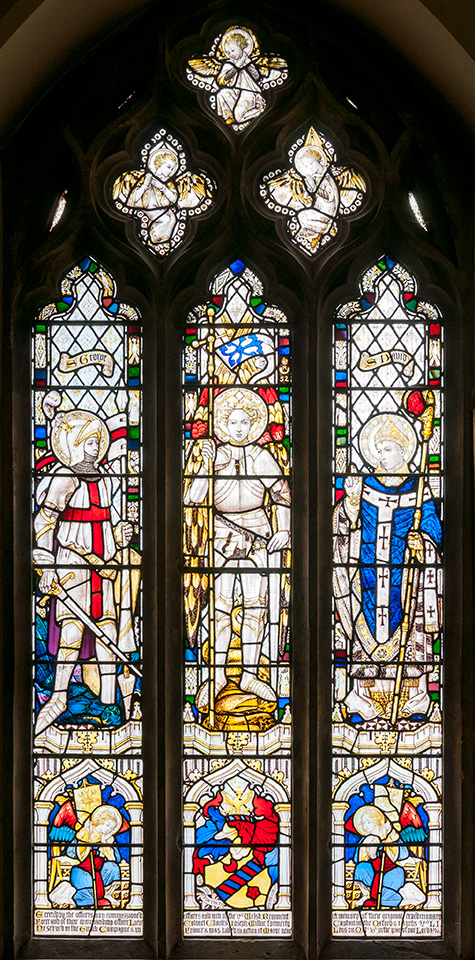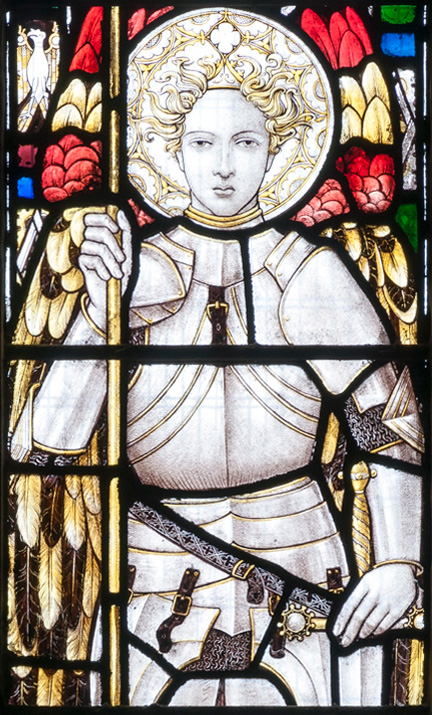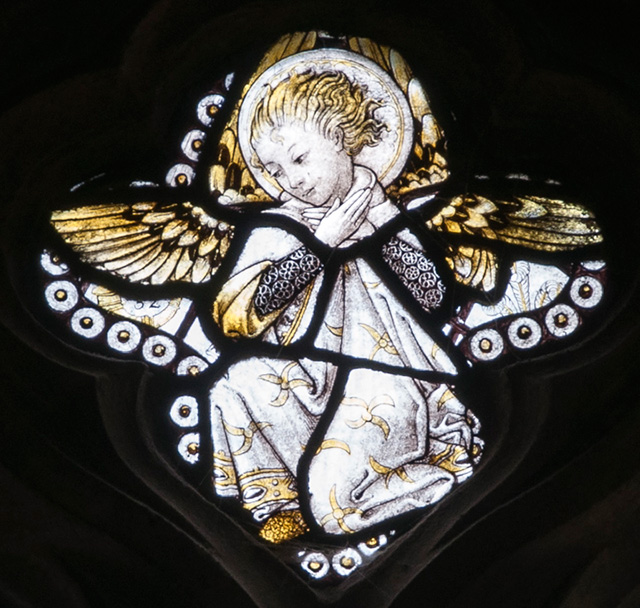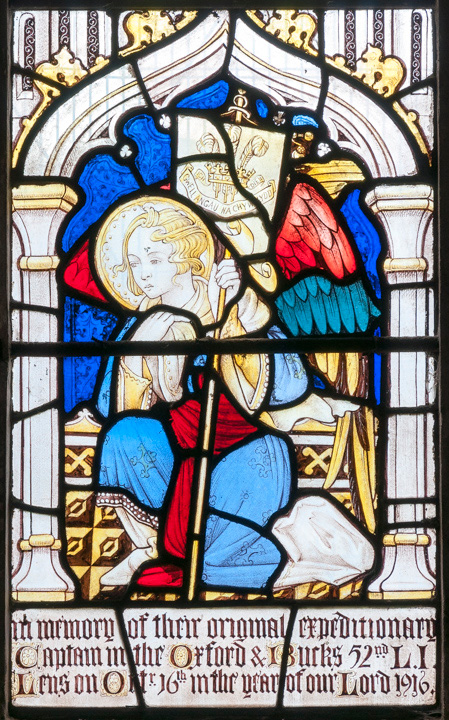In June 2023 I gave talks at a couple of churches as part of the Churches Unlocked Festival, a series of events across the dioceses of Llandaf and Monmouth. In addition to talks and performances, churches were open to visitors over the weekend and some were open for the whole of the two-week period of the festival.
Giving talks at churches is often a two-way exchange. I can share information on the makers, subjects and commissioning of windows and also glean further information and hear additional stories about the stained glass in these buildings from those that attend.
Having prepared a talk on the windows that can be found at the Church of St Basil, Bassaleg, near Newport, I was unprepared to find a booklet concerning one of the windows produced to mark an event at the church in November 2022. I was delighted to find that the booklet revealed the identity of the artist behind a window that has puzzled me for many years since I first visited the church in 2011.
The window commemorates Lieut Col C.J. Wilkie and officers, NCOs and men of the seventeenth battalion of the Welch Regiment, and has three main figures of the archangel Michael and the saints George and David. At first glance it appears to be a fairly conventional late Gothic Revival war memorial window, with standing figures, angels and heraldry. I included it as an example of the combinations of saints found in First World War memorial stained glass in Stained Glass from Welsh Churches in 2014, although I was uncertain about attributing the window.
In the Buildings of Wales volume for Gwent/Monmouthshire, by the late John Newman and published in 2000, it is suggested that the window was probably by Martin Travers. The aesthetic of the window bears some relation to his work, but Travers’ biographer, Micheal Yelton, had confirmed that the window was not by him. The suggested attribution of the window to Travers was provided by Alan Brooks, and prior to the publication of Stained Glass from Welsh Churches I sent him my photo of the window and asked him about it. Seeing the window again he replied that he was of the opinion that the work could be by J.C.N. Bewsey, and although I had sight of only a few windows by him, I tentatively attributed the window to Bewsey, a former employee at the studio of Charles Eamer Kempe.
I was never very happy with this attribution and looked very hard at it again before including a detail of St David in my book Depicting St David in 2020. I had only come across a few more windows by Bewsey in the intervening time and their style differed from this one. I left the illustration unattributed in the new book and placed it in the context of other windows of St David designed and/or made by Herbert Bryans, Frederick Eden, William Bucknall and Ninian Comper. It seemed quite at home in this company and I mused on these designers working in partnerships with other designers and studios in the first quarter of the twentieth century, making stylistic attributions rather difficult. For example, Eden’s windows were made by James Fisher of Fulham before Eden oversaw the making of his windows in his own studio, presumably with different craftsmen; and although I found a newspaper report identifying the architect William Bucknall as the designer of the figures for the east window at Milford Haven, including David, there was no mention of the studio that had made the window.
The main figures and borders of the window at Bassaleg were all quite conventional, although the faces of the three saints and the angels were more distinctive, especially the heads of St Michael and some of the angels with their slightly wild and tightly curled hair. The colouring was brighter and the white glass whiter than in much stained glass made at the time, in common with work of the same period designed by Eden, Comper and Geoffrey Webb.
The booklet at the church in Bassaleg was produced for a rededication of the window on 26 November 2022. It includes a description of the window from the Western Mail (dated 19 February 1921, following the official unveiling more than two years after the completion of the window), a brief history of the battalion commemorated and information about the making of the window. This reveals that the window was designed by Alice Meredith Williams, whose husband Morris Meredith Williams was also an artist and had joined the battalion in 1915. They had met Lieut Col Charles J. Wilkie, named on the window, and his wife Dora while the battalion trained in Wales and England; Charles and Dora had married in the church at Bassaleg in 1897.
Alice Meredith Williams was commissioned to design the window in 1917 and it was made by E.& C. O’Neill of London, who painted the window and had it made and fixed. Intriguingly, the booklet states that she had consulted J.C.N. Bewsey, so the similarities with his work are not coincidental. He had offered to take the project on, and although Williams kept the commission (despite not charging for her work) she followed some of his advice on the design and he recommended the firm of O’Neill’s to her.
E. & C. O’Neill are not a studio whose work I have come across in Wales before. They made windows for other designers including another former employee of C.E. Kempe, C.E. Tute, who shared his address with them at 165 Grays Inn Road. O’Neill’s also appear to have operated from 103 Grays Inn Road, and by 1914 they were based nearby at 4 Heathcote Street, Mecklenburgh Square.
It is possible that the studio made the only window by Tute that I know of in Wales, the remarkable window of 1897 including St Paul preaching to Caractacus and Bendigeidfran at Llandinam. In 1897 Tute was based at 4 Grays Inn Square, close to the addresses occupied by O’Neill’s, and the studio made a scheme of windows for Tute at Crantock in Cornwall shortly after this date, including an impressive east window.
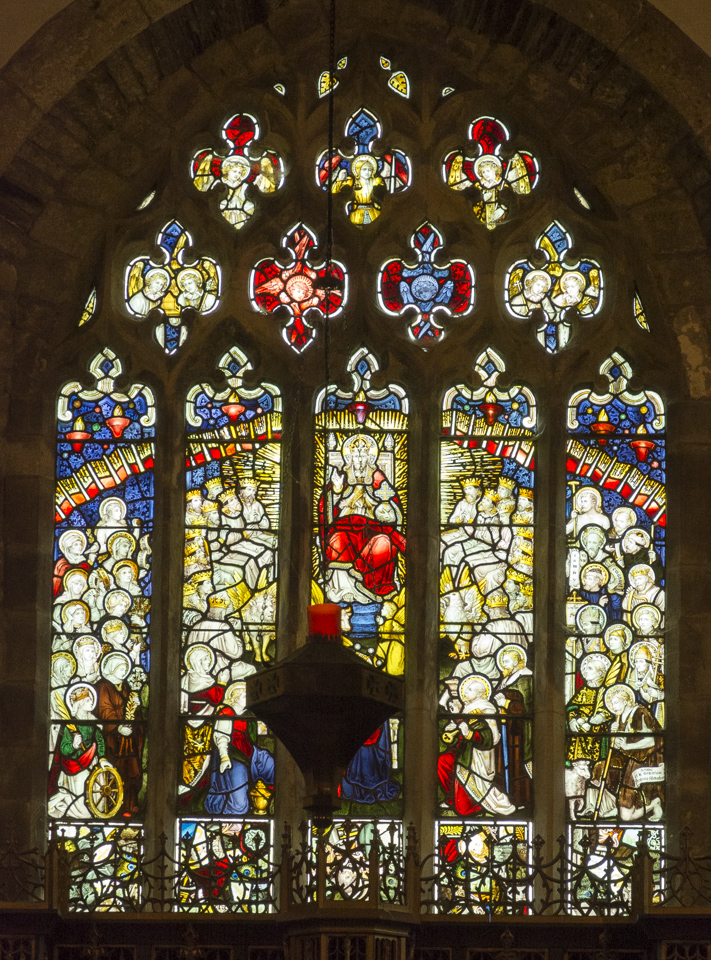
The window at Bassaleg was illustrated in Phyllida Shaw’s excellent book on Alice and Morris Meredith Williams published in 2017, and according to the little booklet at the church Phyllida Shaw attended and spoke at the event for the rededication of the window in 2022. Her book, An Artist’s War: The art and letters of Morris and Alice Meredith Williams, provides ample evidence of the importance of Morris Meredith Williams as a First World War artist, while he served in the same battalion as Charles Wilkie.
Alice Meredith Williams was primarily a sculptor and also drew and painted. Perhaps her most significant work was for the Shrine of the Scottish National War Memorial at Edinburgh Castle, where her the frieze is placed beneath windows by Douglas Strachan; she also made further figures for the building and other powerful monumental sculpture in the aftermath of the First World War. Alice and Morris Meredith Williams designed further windows for churches in Scotland, as well as a set of windows for Bermuda Cathedral. These other windows, as well as others by designed by Morris after Alice died in 1934, look like the work of other makers, probably one of the studios in Scotland that flourished under the influence of the Arts and Crafts Movement in the first half of the twentieth century. Her initial recourse to Bewsey would suggest that the window at Bassaleg was her first window.
The memorial window to Lieut Col C.J. Wilkie and the seventeenth battalion of the Welch Regiment at Bassaleg represents an excellent example of the occasional partnerships and collaborations between particular artists, designers and studios, which can only be tracked down through archival work. These are the kind of windows that usually elude stylistic attribution – in this case it is perhaps the only example of a window by the artist being made by the studio, perhaps making it unique.
Notes
Information on the addresses of E. & C. O’Neill and C.E. Tute is from the ‘Architects and Artists’ section of Sussex Parish Churches; Joyce Little, Stained Glass Marks and Monograms ed. Angela Goedicke and Margaret Washbourn (National Association of Decorative and Fine Art Societies, 2002); and an article on the scheme at Carantoc by Michael G. Swift and Jeni Stewart-Smith on the Cornish Stained Glass site.
For Alice and Morris Meredith Williams, see:
Phyllida Shaw, An Artist’s War: The art and letters of Morris and Alice Meredith Williams (Stroud: History Press, 2017).
Phyllida Shaw, Undaunted Spirit: The Art and Craft of Gertrude Alice Meredith Williams (Independent Publishing Network, 2019).

